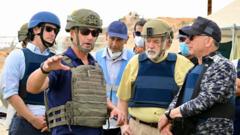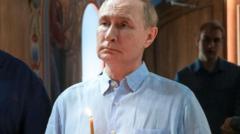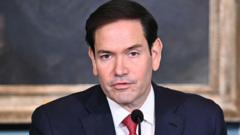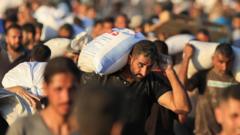During his controversial visit to a Gaza aid distribution site, U.S. envoy Steve Witkoff faced criticism from locals and conflicting reports regarding civilian casualties and the humanitarian crisis in the region. The visit aimed to assess Gaza Humanitarian Foundation's operations amidst ongoing violence.
Trump Envoy's Visit to Gaza Aid Site Sparks Controversy and Criticism

Trump Envoy's Visit to Gaza Aid Site Sparks Controversy and Criticism
Steve Witkoff, U.S. envoy for the Middle East, visits Gaza amid escalating tensions and conflicting reports about aid distribution and civilian casualties.
The ongoing humanitarian crisis in Gaza has drawn international attention, especially following the visit of U.S. envoy to the Middle East, Steve Witkoff, who, alongside U.S. Ambassador to Israel Mike Huckabee, toured an Israel- and U.S.-backed aid distribution site. This visit marked Witkoff's first engagement at such a controversial location, which has been accused of being linked to numerous civilian casualties amid an escalating conflict.
The delegation aimed to "learn the truth" regarding the activities of the Gaza Humanitarian Foundation (GHF). Reports indicate a staggering number of at least 859 Palestinians have been killed near these aid points, a figure that the GHF has publicly rejected, claiming their operations are crucial for alleviating hunger in the region. Huckabee praised the aid efforts, emphasizing that GHF sites were reportedly delivering "more than one million meals a day," despite the UN asserting that these figures are significantly insufficient to meet the nutritional needs of the population.
Witkoff and Huckabee's visit comes amidst allegations of lethal violence at GHF sites. Eyewitness accounts and reports from local medics have indicated that Israeli military forces have repeatedly opened fire on crowds near these facilities. One veteran U.S. special forces officer, Lt. Col. Anthony Aguilar, has described witnessing "brutality" against unarmed civilians at these sites, a statement that has spurred further scrutiny of both the aid operations and the military's tactics.
The GHF, which has taken over the distribution of aid amidst claims of UN aid being looted by Hamas, operates its sites under the oversight of U.S. private security contractors and within Israeli military zones. This shift has sparked outrage and raised questions about transparency and accountability, particularly when independent international journalists face restrictions on entry into Gaza.
Local residents of Gaza have expressed deep skepticism regarding Witkoff's visit, with some labeling it a "media stunt" devoid of genuine intent to address the pressing humanitarian needs. Comments from Gazans indicate a desperate call for an end to the ongoing violence and lift on the blockade, casting doubt on the efficacy of external diplomatic efforts.
As the conflict escalates, with more than 60,000 reported casualties, international observers await a strategic overhaul in ceasefire negotiations. Recent discussions suggest an ambitious proposal aimed at securing the release of hostages held by Hamas in exchange for comprehensive disarmament—a proposal steeped in complexity and fraught with opposition from both sides.
As the situation continues to deteriorate, the efficacy of aid distribution along with the realities of civilian safety remain at the forefront of this evolving narrative in the Gaza Strip, drawing urgent calls for clear and meaningful intervention from the international community.



















